key battery BMW X3 3.0I 2005 E83 Owner's Manual
[x] Cancel search | Manufacturer: BMW, Model Year: 2005, Model line: X3 3.0I, Model: BMW X3 3.0I 2005 E83Pages: 126, PDF Size: 4.65 MB
Page 13 of 126

Cockpit
12
Colors
The indicator and warning lamps can light up in
different colors and combinations.
The following section explains the significance
of the individual colors as well as how you
should respond when they appear.
>red:
Stop the vehicle immediately
or
an important reminder
>yellow:
Have the system inspected as soon as
possible
or
For your information
>green:
For your information
>blue:
For your information
Buttons on steering wheel*
The buttons integrated into the steering wheel
are provided so that you can operate a number
of accessories quickly and without being dis-
tracted from traffic conditions. You may oper-
ate:
>Selected audio source functions
>Recirculated-air mode/steering wheel
heater Brake warning lamp for Canadian
models
Driving stability control systems/
ABS Antilock Brake System
+49
ABS Antilock Brake System/chassis
control system for Canadian models
Brake pads
+92
DSC Dynamic Stability Control/
xDrive
+ 47, 49
Flat Tire Monitor
+49
Automatic transmission
+36
Engine oil
+90
Service Engine Soon
+94
Service Engine Soon warning lamp for
Canadian models
Check Gas Cap
* +80
Engine electronics
+34
Battery charge current
+101
Topping off coolant91
Topping off washer fluid90
Lamp defective53
Turn signals38
Front fog lamps54
Headlamp flasher38
High beams54
Cruise control40
Indicates from ignition key in posi-
tion 2 when a door or the tailgate is
opened.
Page 17 of 126

Opening and closing
16
Opening and closing
Key set
1Master keys with remote control
Every master key with remote control con-
tains an extended-life battery as a power
supply, which is charged automatically in
the ignition lock as you drive. You should
use each master key at least twice a year in
order to maintain the charge condition.
Depending on which master key is detected
by the vehicle during unlocking, different
settings in the vehicle are requested and
executed, refer to Vehicle and Key Memory
on page30.
2Spare key
For storage in a safe place, such as in your
wallet.
This key does not fit in the lock of the glove
compartment. This is an advantage, e.g.
when valet parking at a hotel. The key is not
intended for constant use.
Replacement keys
Replacement and additional keys are available
from your BMW Sport Activity Vehicle Center.
Central locking system
The concept
The central locking system is ready for opera-
tion whenever the driver's door is closed. The
system engages or releases the locks on the
>doors
>tailgate
>fuel filler door
The central locking system can be operated
from the outside
>via the remote control
>via the driver's door lock
and from inside via the button for the central
locking system.
When the system is locked from inside, the fuel
filler door remains unlocked, refer to page18.
The anti-theft system is automatically activated
whenever you activate the central locking sys-
tem from outside the vehicle. This prevents the
doors from being unlocked via the lock buttons
or door handles. The alarm system is also
armed or disarmed.
In the event of a serious accident, the central
locking system unlocks automatically. In addi-
tion, the hazard warning flashers and interior
lamps switch on.
Opening and closing: from
outside
Using the remote control
When you engage/release the vehicle locks,
you also activate/deactivate the anti-theft sys-
tem, arm/disarm
the alarm system, and switch
the interior lamps on/off.
You can set an acoustic signal to remind
you if the ignition key is still in the ignition
lock after you open the driver's door.<
Page 18 of 126
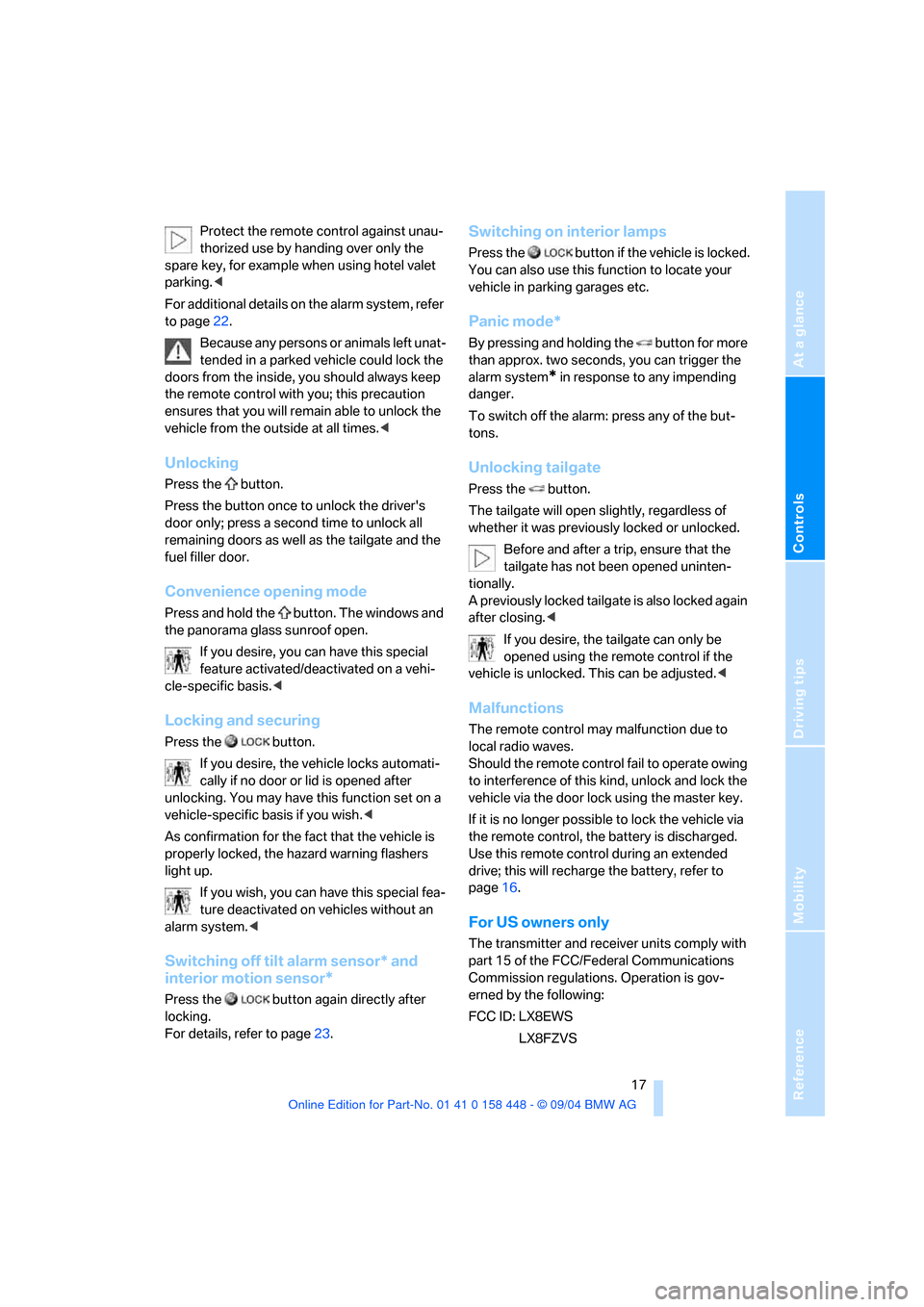
Reference
At a glance
Controls
Driving tips
Mobility
17
Protect the remote control against unau-
thorized use by handing over only the
spare key, for example when using hotel valet
parking.<
For additional details on the alarm system, refer
to page22.
Because any persons or animals left unat-
tended in a parked vehicle could lock the
doors from the inside, you should always keep
the remote control with you; this precaution
ensures that you will remain able to unlock the
vehicle from the outside at all times.<
Unlocking
Press the button.
Press the button once to unlock the driver's
door only; press a second time to unlock all
remaining doors as well as the tailgate and the
fuel filler door.
Convenience opening mode
Press and hold the button. The windows and
the panorama glass sunroof open.
If you desire, you can have this special
feature activated/deactivated on a vehi-
cle-specific basis.<
Locking and securing
Press the button.
If you desire, the vehicle locks automati-
cally if no door or lid is opened after
unlocking. You may have this function set on a
vehicle-specific basis if you wish.<
As confirmation for the fact that the vehicle is
properly locked, the hazard warning flashers
light up.
If you wish, you can have this special fea-
ture deactivated on vehicles without an
alarm system.<
Switching off tilt alarm sensor* and
interior motion sensor
*
Press the button again directly after
locking.
For details, refer to page23.
Switching on interior lamps
Press the button if the vehicle is locked.
You can also use this function to locate your
vehicle in parking garages etc.
Panic mode*
By pressing and holding the button for more
than approx. two seconds, you can trigger the
alarm system
* in response to any impending
danger.
To switch off the alarm: press any of the but-
tons.
Unlocking tailgate
Press the button.
The tailgate will open slightly, regardless of
whether it was previously locked or unlocked.
Before and after a trip, ensure that the
tailgate has not been opened uninten-
tionally.
A previously locked tailgate is also locked again
after closing.<
If you desire, the tailgate can only be
opened using the remote control if the
vehicle is unlocked. This can be adjusted.<
Malfunctions
The remote control may malfunction due to
local radio waves.
Should the remote control fail to operate owing
to interference of this kind, unlock and lock the
vehicle via the door lock using the master key.
If it is no longer possible to lock the vehicle via
the remote control, the battery is discharged.
Use this remote control during an extended
drive; this will recharge the battery, refer to
page16.
For US owners only
The transmitter and receiver units comply with
part 15 of the FCC/Federal Communications
Commission regulations. Operation is gov-
erned by the following:
FCC ID: LX8EWS
LX8FZVS
Page 21 of 126
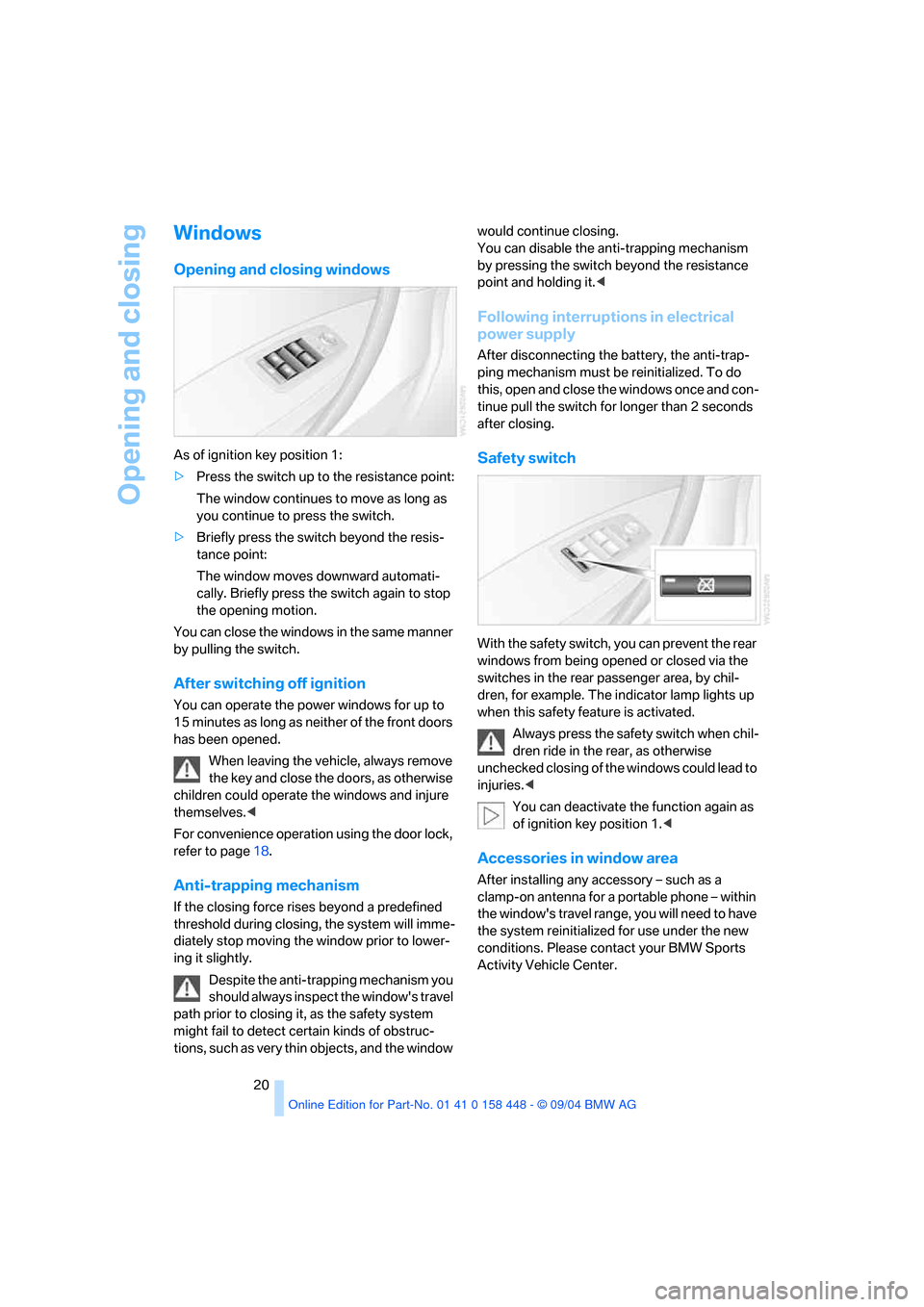
Opening and closing
20
Windows
Opening and closing windows
As of ignition key position 1:
>Press the switch up to the resistance point:
The window continues to move as long as
you continue to press the switch.
>Briefly press the switch beyond the resis-
tance point:
The window moves downward automati-
cally. Briefly press the switch again to stop
the opening motion.
You can close the windows in the same manner
by pulling the switch.
After switching off ignition
You can operate the power windows for up to
15 minutes as long as neither of the front doors
has been opened.
When leaving the vehicle, always remove
the key and close the doors, as otherwise
children could operate the windows and injure
themselves.<
For convenience operation using the door lock,
refer to page18.
Anti-trapping mechanism
If the closing force rises beyond a predefined
threshold during closing, the system will imme-
diately stop moving the window prior to lower-
ing it slightly.
Despite the anti-trapping mechanism you
should always inspect the window's travel
path prior to closing it, as the safety system
might fail to detect certain kinds of obstruc-
tions, such as very thin objects, and the window would continue closing.
You can disable the anti-trapping mechanism
by pressing the switch beyond the resistance
point and holding it.<
Following interruptions in electrical
power supply
After disconnecting the battery, the anti-trap-
ping mechanism must be reinitialized. To do
this, open and close the windows once and con-
tinue pull the switch for longer than 2 seconds
after closing.
Safety switch
With the safety switch, you can prevent the rear
windows from being opened or closed via the
switches in the rear passenger area, by chil-
dren, for example. The indicator lamp lights up
when this safety feature is activated.
Always press the safety switch when chil-
dren ride in the rear, as otherwise
unchecked closing of the windows could lead to
injuries.<
You can deactivate the function again as
of ignition key position 1.<
Accessories in window area
After installing any accessory – such as a
clamp-on antenna for a portable phone – within
the window's travel range, you will need to have
the system reinitialized for use under the new
conditions. Please contact your BMW Sports
Activity Vehicle Center.
Page 22 of 126
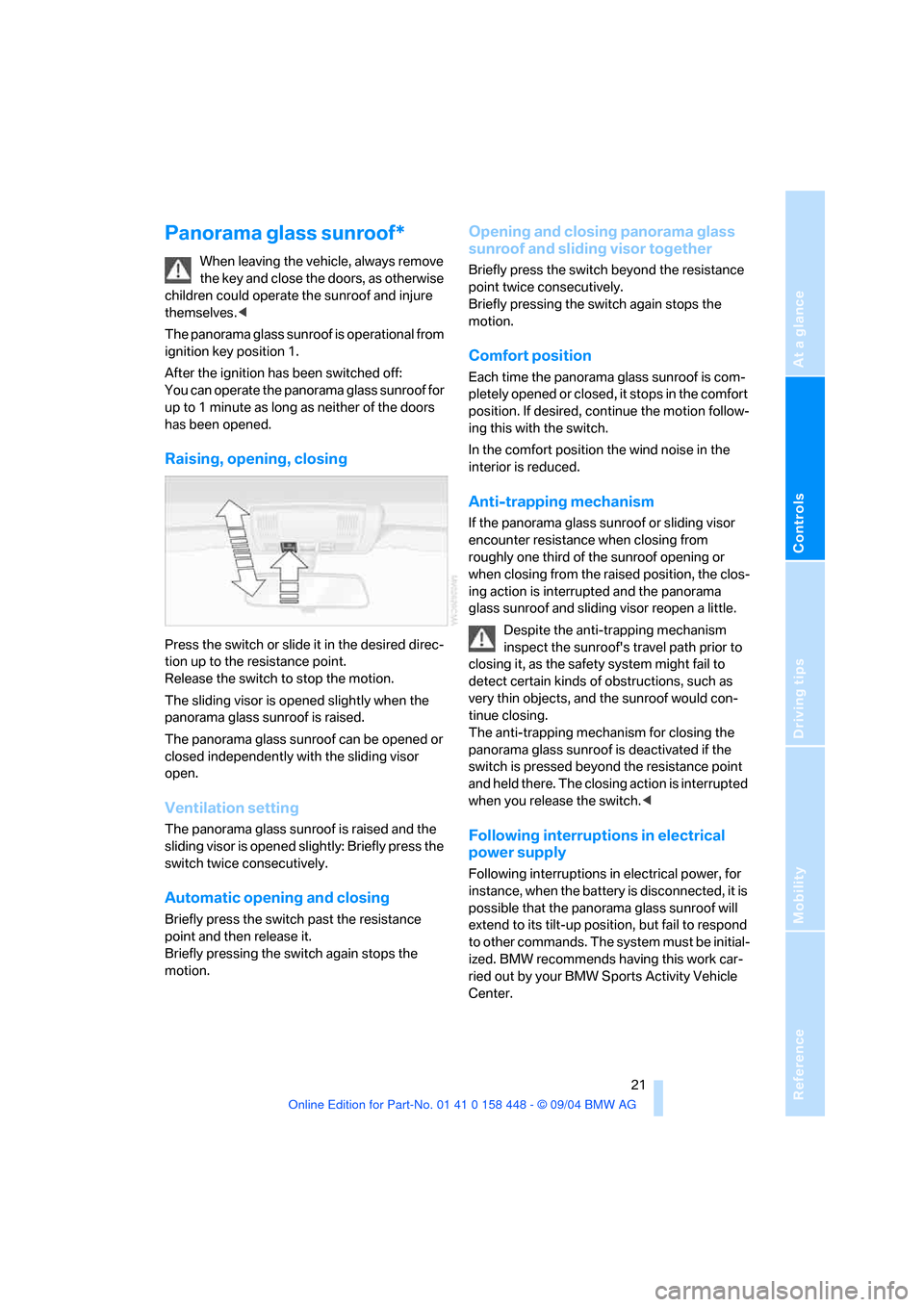
Reference
At a glance
Controls
Driving tips
Mobility
21
Panorama glass sunroof*
When leaving the vehicle, always remove
the key and close the doors, as otherwise
children could operate the sunroof and injure
themselves.<
The panorama glass sunroof is operational from
ignition key position 1.
After the ignition has been switched off:
You can operate the panorama glass sunroof for
up to 1 minute as long as neither of the doors
has been opened.
Raising, opening, closing
Press the switch or slide it in the desired direc-
tion up to the resistance point.
Release the switch to stop the motion.
The sliding visor is opened slightly when the
panorama glass sunroof is raised.
The panorama glass sunroof can be opened or
closed independently with the sliding visor
open.
Ventilation setting
The panorama glass sunroof is raised and the
sliding visor is opened slightly: Briefly press the
switch twice consecutively.
Automatic opening and closing
Briefly press the switch past the resistance
point and then release it.
Briefly pressing the switch again stops the
motion.
Opening and closing panorama glass
sunroof and sliding visor together
Briefly press the switch beyond the resistance
point twice consecutively.
Briefly pressing the switch again stops the
motion.
Comfort position
Each time the panorama glass sunroof is com-
pletely opened or closed, it stops in the comfort
position. If desired, continue the motion follow-
ing this with the switch.
In the comfort position the wind noise in the
interior is reduced.
Anti-trapping mechanism
If the panorama glass sunroof or sliding visor
encounter resistance when closing from
roughly one third of the sunroof opening or
when closing from the raised position, the clos-
ing action is interrupted and the panorama
glass sunroof and sliding visor reopen a little.
Despite the anti-trapping mechanism
inspect the sunroof's travel path prior to
closing it, as the safety system might fail to
detect certain kinds of obstructions, such as
very thin objects, and the sunroof would con-
tinue closing.
The anti-trapping mechanism for closing the
panorama glass sunroof is deactivated if the
switch is pressed beyond the resistance point
and held there. The closing action is interrupted
when you release the switch.<
Following interruptions in electrical
power supply
Following interruptions in electrical power, for
instance, when the battery is disconnected, it is
possible that the panorama glass sunroof will
extend to its tilt-up position, but fail to respond
to other commands. The system must be initial-
ized. BMW recommends having this work car-
ried out by your BMW Sports Activity Vehicle
Center.
Page 23 of 126

Opening and closing
22
Manual operation
In the event of an electrical malfunction, you can
operate the panorama glass sunroof manually.
1.Pull off the cover firmly downward.
2.Insert the Allen wrench from the compart-
ment beneath the cargo area floor, refer to
page99, into the proper opening and turn
the panorama glass sunroof in the desired
direction. Direction of rotation for closing,
refer to arrow.
Alarm system*
The concept
The vehicle alarm system responds:
>When a door, the hood, or the tailgate is
opened.
>To movements inside the vehicle: interior
motion sensor, refer to Tilt alarm sensor
and interior motion sensor.
>To changes in the vehicle tilt angle such as
occur during attempts to steal the wheels or
tow the vehicle.
>To interruptions in battery voltage.The system responds to unauthorized vehicle
entry and attempted theft by simultaneously
activating:
>The acoustic alarm for approx. 30 seconds.
>The hazard warning flashers for approx.
5minutes.
>The high beams, which flash on and off in
the same rhythm.
Arming and disarming alarm system
When you lock or unlock the vehicle, either with
the remote control or at the door lock, the alarm
system is armed or disarmed at the same time.
If the alarm system has been properly armed,
the hazard warning flashers light up once.
You can have different acknowledgment
signals set to confirm arming and disarm-
ing.<
You can also open the tailgate with the system
armed using the button on the remote con-
trol, refer to page17. When you close the tail-
gate, the system is rearmed.
Switching off alarm
>Unlock the vehicle using the remote control,
refer to page17.
or
>Turn the ignition key to position 1.
Indicator lamp displays
>The indicator lamp below the interior rear-
view mirror flashes continuously: the sys-
tem is armed.
Page 35 of 126
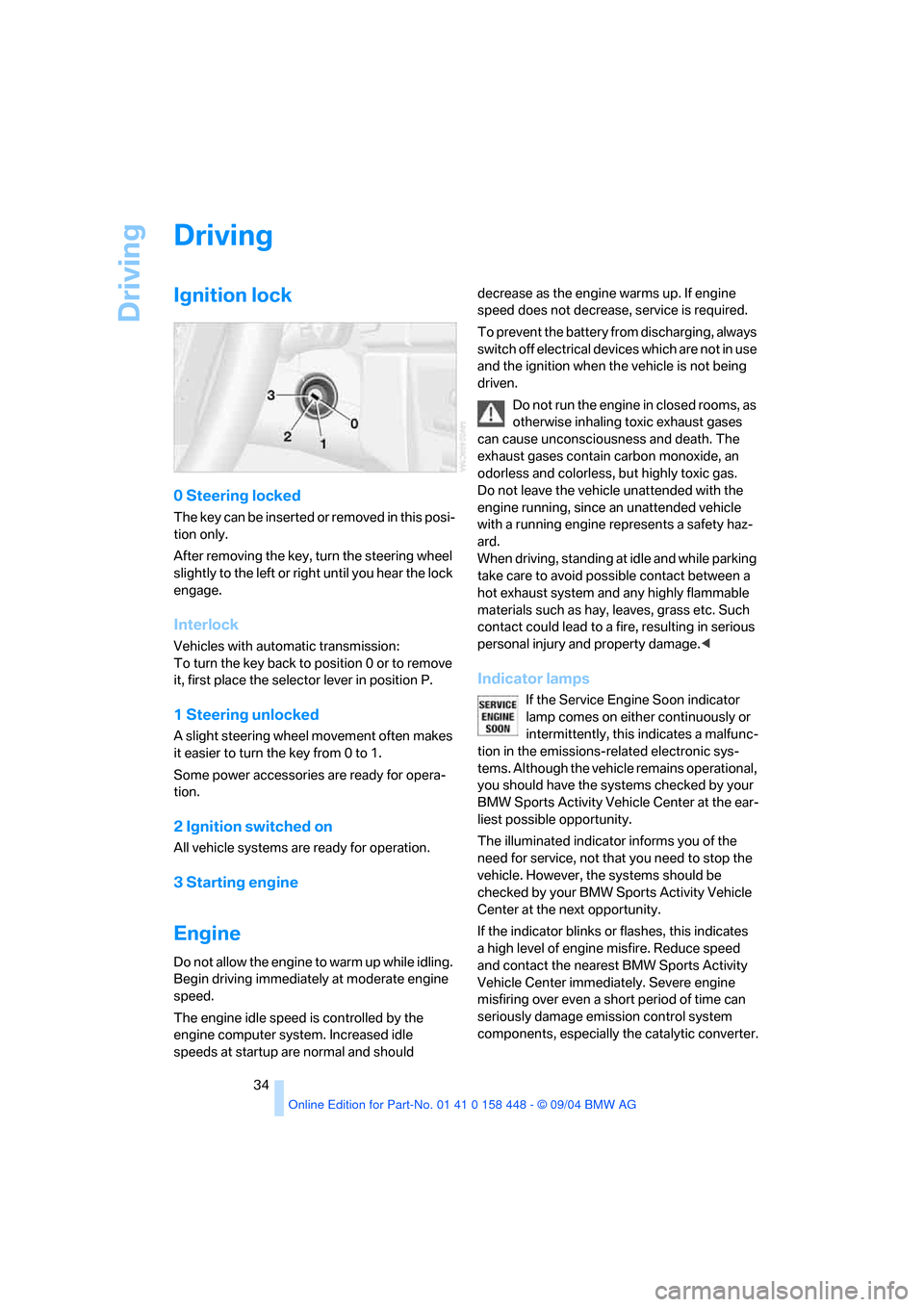
Driving
34
Driving
Ignition lock
0 Steering locked
T h e k e y c a n b e in s e r t e d o r r e m o v e d in t h i s p o s i-
tion only.
After removing the key, turn the steering wheel
slightly to the left or right until you hear the lock
engage.
Interlock
Vehicles with automatic transmission:
To turn the key back to position 0 or to remove
it, first place the selector lever in position P.
1 Steering unlocked
A slight steering wheel movement often makes
it easier to turn the key from 0 to 1.
Some power accessories are ready for opera-
tion.
2 Ignition switched on
All vehicle systems are ready for operation.
3 Starting engine
Engine
Do not allow the engine to warm up while idling.
Begin driving immediately at moderate engine
speed.
The engine idle speed is controlled by the
engine computer system. Increased idle
speeds at startup are normal and should decrease as the engine warms up. If engine
speed does not decrease, service is required.
To prevent the battery from discharging, always
switch off electrical devices which are not in use
and the ignition when the vehicle is not being
driven.
Do not run the engine in closed rooms, as
otherwise inhaling toxic exhaust gases
can cause unconsciousness and death. The
exhaust gases contain carbon monoxide, an
odorless and colorless, but highly toxic gas.
Do not leave the vehicle unattended with the
engine running, since an unattended vehicle
with a running engine represents a safety haz-
ard.
When driving, standing at idle and while parking
take care to avoid possible contact between a
hot exhaust system and any highly flammable
materials such as hay, leaves, grass etc. Such
contact could lead to a fire, resulting in serious
personal injury and property damage.<
Indicator lamps
If the Service Engine Soon indicator
lamp comes on either continuously or
intermittently, this indicates a malfunc-
tion in the emissions-related electronic sys-
tems. Although the vehicle remains operational,
you should have the systems checked by your
BMW Sports Activity Vehicle Center at the ear-
liest possible opportunity.
The illuminated indicator informs you of the
need for service, not that you need to stop the
vehicle. However, the systems should be
checked by your BMW Sports Activity Vehicle
Center at the next opportunity.
If the indicator blinks or flashes, this indicates
a high level of engine misfire. Reduce speed
and contact the nearest BMW Sports Activity
Vehicle Center immediately. Severe engine
misfiring over even a short period of time can
seriously damage emission control system
components, especially the catalytic converter.
Page 96 of 126

Reference
At a glance
Controls
Driving tips
Mobility
95
Replacing components
Onboard tool kit
The onboard tool kit is located in a compart-
ment on the left in the cargo area.
Replacing wiper blades
Front
1.Move the wiper into the fold-out position,
refer to page38.
2.Lift the wiper arm and press the securing
spring, refer to arrow.
3.Pull the wiper blade off toward the wiper
arm.
4.Insert the new blade and snap it into place.
Fold the wipers back down onto the wind-
shield before you turn the ignition key to
p o s i t i o n 1 o r 2 a g a i n . I f y o u d o n o t , t h e y c o u l d b e
damaged.<
Rear
1.Lift the wiper arm.
2.Pull off the wiper blade, refer to arrow.
3.Insert a new wiper blade.
Lamps and bulbs
The lamps and bulbs make essential contribu-
tions to the safety of your vehicle. Therefore,
comply fully with the following instructions dur-
ing bulb replacement. If you are not familiar with
the specified procedures, BMW recommends
having the replacements carried out at your
BMW Sports Activity Vehicle Center.
Never touch the glass of new bulbs with
your bare fingers, as even minute
amounts of contamination will burn into the
bulb's surface and reduce its service life. To
install, use a clean cloth, napkin etc. or hold the
bulb by its metal socket.<
A replacement bulb set is available from your
BMW Sports Activity Vehicle Center.
To prevent short circuits, before working
on any electrical system, equipment or
accessory you should always switch it off and
disconnect the cable from the battery's nega-
tive terminal before starting.
To avoid possible injury or equipment damage
when replacing bulbs, observe any instructions
provided by the bulb manufacturer.<
When maintaining the headlamps, please
comply with the instructions in the sepa-
rate Caring for your vehicle brochure.<
Page 106 of 126
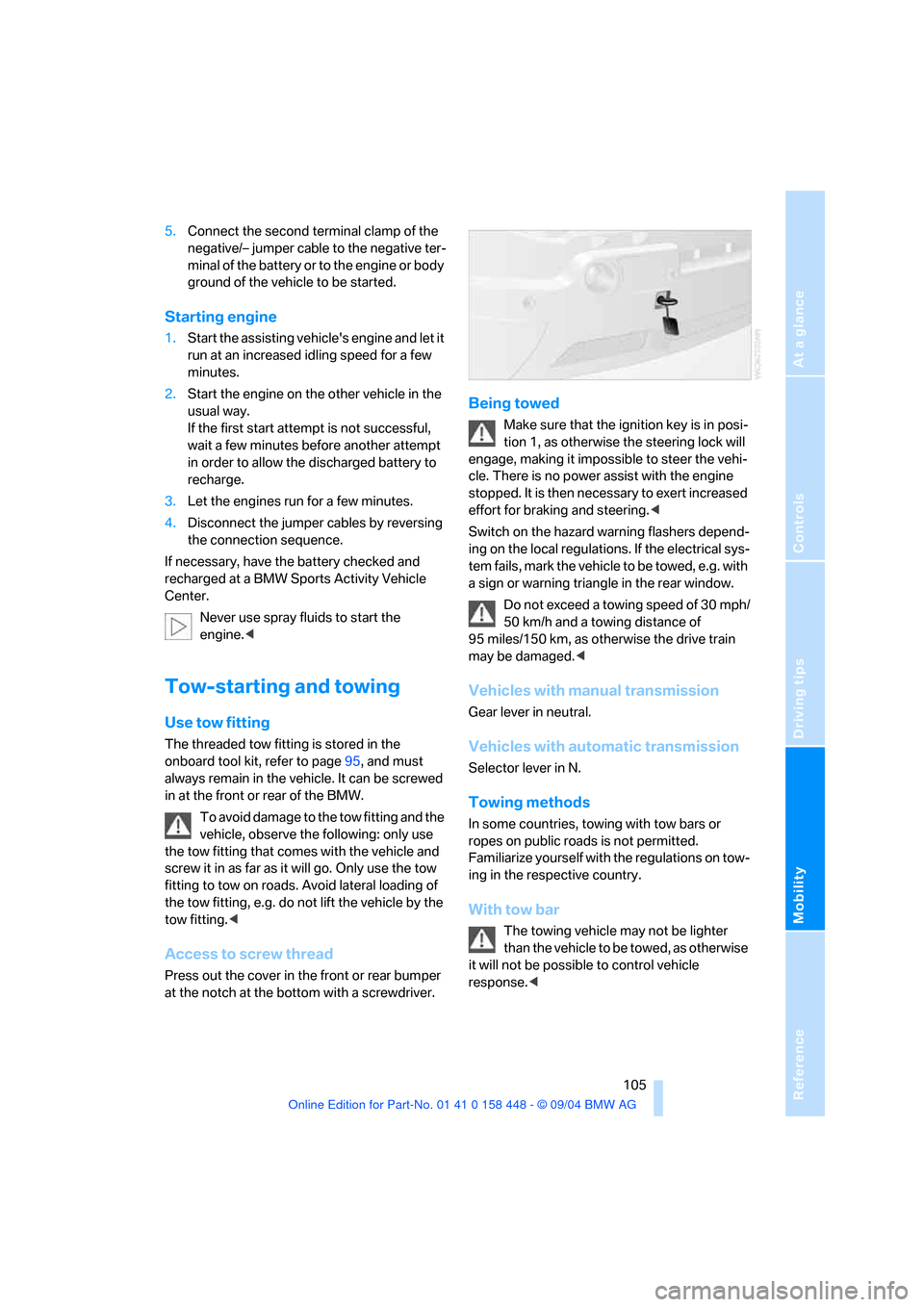
Reference
At a glance
Controls
Driving tips
Mobility
105
5.Connect the second terminal clamp of the
negative/– jumper cable to the negative ter-
minal of the battery or to the engine or body
ground of the vehicle to be started.
Starting engine
1.Start the assisting vehicle's engine and let it
run at an increased idling speed for a few
minutes.
2.Start the engine on the other vehicle in the
usual way.
If the first start attempt is not successful,
wait a few minutes before another attempt
in order to allow the discharged battery to
recharge.
3.Let the engines run for a few minutes.
4.Disconnect the jumper cables by reversing
the connection sequence.
If necessary, have the battery checked and
recharged at a BMW Sports Activity Vehicle
Center.
Never use spray fluids to start the
engine.<
Tow-starting and towing
Use tow fitting
The threaded tow fitting is stored in the
onboard tool kit, refer to page95, and must
always remain in the vehicle. It can be screwed
in at the front or rear of the BMW.
To avoid damage to the tow fitting and the
vehicle, observe the following: only use
the tow fitting that comes with the vehicle and
screw it in as far as it will go. Only use the tow
fitting to tow on roads. Avoid lateral loading of
the tow fitting, e.g. do not lift the vehicle by the
tow fitting.<
Access to screw thread
Press out the cover in the front or rear bumper
at the notch at the bottom with a screwdriver.
Being towed
Make sure that the ignition key is in posi-
tion 1, as otherwise the steering lock will
engage, making it impossible to steer the vehi-
cle. There is no power assist with the engine
stopped. It is then necessary to exert increased
effort for braking and steering.<
Switch on the hazard warning flashers depend-
ing on the local regulations. If the electrical sys-
tem fails, mark the vehicle to be towed, e.g. with
a sign or warning triangle in the rear window.
Do not exceed a towing speed of 30 mph/
50 km/h and a towing distance of
95 miles/150 km, as otherwise the drive train
may be damaged.<
Vehicles with manual transmission
Gear lever in neutral.
Vehicles with automatic transmission
Selector lever in N.
Towing methods
In some countries, towing with tow bars or
ropes on public roads is not permitted.
Familiarize yourself with the regulations on tow-
ing in the respective country.
With tow bar
The towing vehicle may not be lighter
than the vehicle to be towed, as otherwise
it will not be possible to control vehicle
response.<
Page 115 of 126
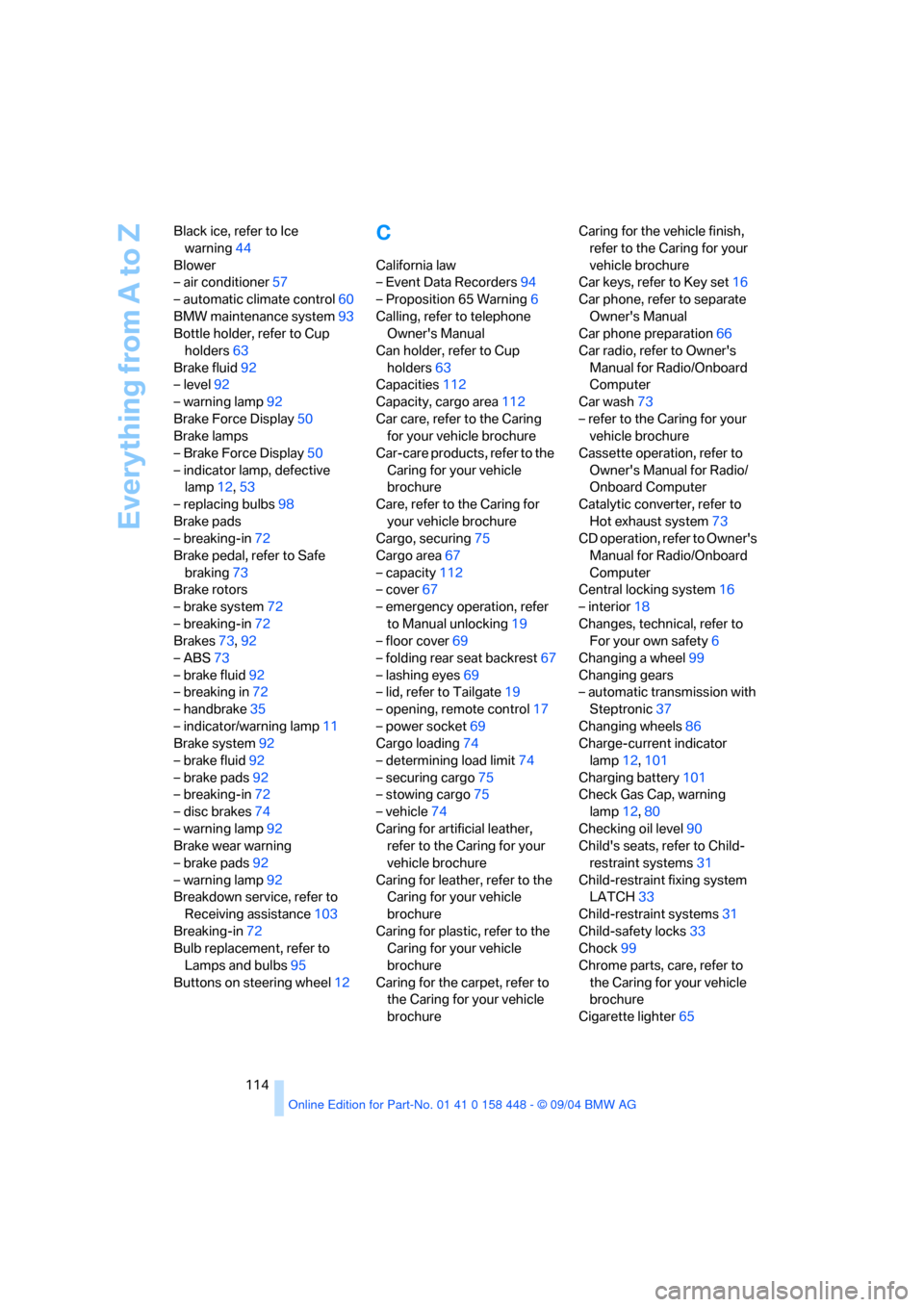
Everything from A to Z
114 Black ice, refer to Ice
warning44
Blower
– air conditioner57
– automatic climate control60
BMW maintenance system93
Bottle holder, refer to Cup
holders63
Brake fluid92
– level92
– warning lamp92
Brake Force Display50
Brake lamps
– Brake Force Display50
– indicator lamp, defective
lamp12,53
– replacing bulbs98
Brake pads
– breaking-in72
Brake pedal, refer to Safe
braking73
Brake rotors
– brake system72
– breaking-in72
Brakes73,92
– ABS73
– brake fluid92
– breaking in72
– handbrake35
– indicator/warning lamp11
Brake system92
– brake fluid92
– brake pads92
– breaking-in72
– disc brakes74
– warning lamp92
Brake wear warning
– brake pads92
– warning lamp92
Breakdown service, refer to
Receiving assistance103
Breaking-in72
Bulb replacement, refer to
Lamps and bulbs95
Buttons on steering wheel12
C
California law
– Event Data Recorders94
– Proposition 65 Warning6
Calling, refer to telephone
Owner's Manual
Can holder, refer to Cup
holders63
Capacities112
Capacity, cargo area112
Car care, refer to the Caring
for your vehicle brochure
Car-care products, refer to the
Caring for your vehicle
brochure
Care, refer to the Caring for
your vehicle brochure
Cargo, securing75
Cargo area67
– capacity112
– cover67
– emergency operation, refer
to Manual unlocking19
– floor cover69
– folding rear seat backrest67
– lashing eyes69
– lid, refer to Tailgate19
– opening, remote control17
– power socket69
Cargo loading74
– determining load limit74
– securing cargo75
– stowing cargo75
– vehicle74
Caring for artificial leather,
refer to the Caring for your
vehicle brochure
Caring for leather, refer to the
Caring for your vehicle
brochure
Caring for plastic, refer to the
Caring for your vehicle
brochure
Caring for the carpet, refer to
the Caring for your vehicle
brochureCaring for the vehicle finish,
refer to the Caring for your
vehicle brochure
Car keys, refer to Key set16
Car phone, refer to separate
Owner's Manual
Car phone preparation66
Car radio, refer to Owner's
Manual for Radio/Onboard
Computer
Car wash73
– refer to the Caring for your
vehicle brochure
Cassette operation, refer to
Owner's Manual for Radio/
Onboard Computer
Catalytic converter, refer to
Hot exhaust system73
CD operation, refer to Owner's
Manual for Radio/Onboard
Computer
Central locking system16
– interior18
Changes, technical, refer to
For your own safety6
Changing a wheel99
Changing gears
– automatic transmission with
Steptronic37
Changing wheels86
Charge-current indicator
lamp12,101
Charging battery101
Check Gas Cap, warning
lamp12,80
Checking oil level90
Child's seats, refer to Child-
restraint systems31
Child-restraint fixing system
LATCH33
Child-restraint systems31
Child-safety locks33
Chock99
Chrome parts, care, refer to
the Caring for your vehicle
brochure
Cigarette lighter65